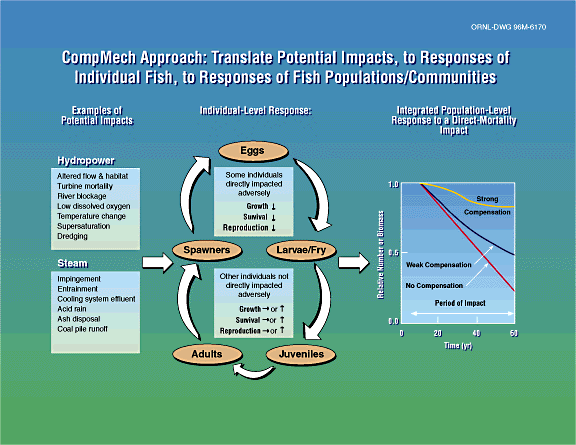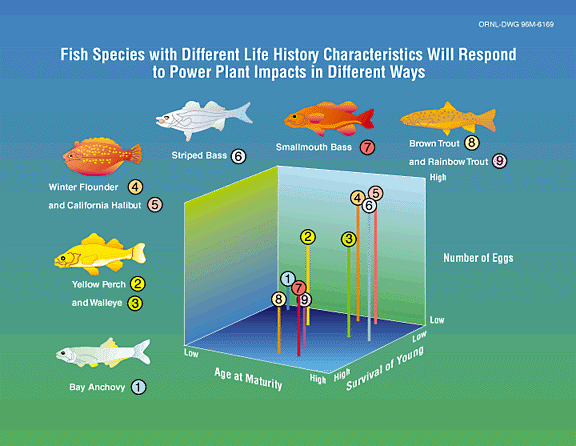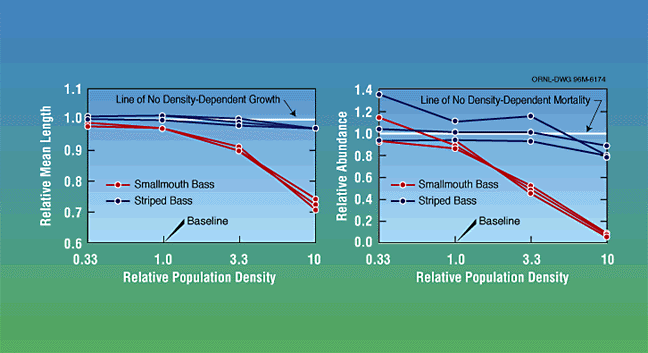
Fish are an important natural resource. Fish populations are an integral component of aquatic ecosystems and often a barometer of ecosystem health. Finfish and shellfish in both freshwater and marine habitats are also important economically--sport and commercial fishing are the bases for major industries. Because of the value of fish populations, and their sensitivity to changes in their environment, assessing the potential impacts of environmental change on fishery resources is a dominant component of any licensing or permitting activity involving aquatic ecosystems.
Utility operations can have a number of impacts on fish populations, and other industries and activities, such as agriculture, mining, and fishing, involve analogous stressors. Management of fish populations must take account of all these impacts in the context of balancing the risks to fish populations against multiple uses of limited water resources.
Recent trends in water resource/fisheries management emphasize an approach that is both more practical and more scientifically supportable than past practices. This approach reflects the development of new technologies for data collection, analysis, and modeling, combined with the experience gained from many decades of successful as well as unsuccessful management of fishery resources. EPRI's CompMech program has played a role over the past decade in the continuing evolution of this approach. The CompMech modeling approach provides a powerful framework for objectively defining issues, designing studies and monitoring programs, and predicting the effects on fish populations of alternative power-plant operational scenarios and mitigation measures.1,2,3,4
The EPRI program on compensatory mechanisms in fish populations (CompMech) has the objective of improving predictions of fish population response to increased mortality, loss of habitat, and release of toxicants. The program was initiated in 1987, based on a decade of prior planning by EPRI, member utilities, and academic and agency scientists. The program's longevity and productivity, and the extensive involvement of utilities as well as government resource and regulatory agencies, attest to the accomplishments of CompMech. Besides the large number of successful applications completed to date (see representative applications described below), program outputs include more than 70 journal publications and reports, as well as 20 workshops with the participation of utility and state regulatory and resource representatives and academic scientists. A particularly productive aspect of CompMech has been the program's support of talented graduate students applying the CompMech approach in research as part of their academic training. These fellowship recipients have in turn greatly expanded the resources and reputation of CompMech.
The CompMech approach over the past decade has been to represent in simulation models the processes underlying the growth, reproduction, and survival of individual fish and then to aggregate over individuals to the population level. Models have been developed and applied to key species representing a cross-section of life-history strategies5 (Figure 1). These particular species are known to experience mortalities and/or habitat alterations because of the operation of steam and hydroelectric generation facilities. Models for additional species are developed by modifying modules from these existing models.
 |
Figure 1. Relative position of nine representative North American fish species within three-dimensional life-history space, as defined by the axes for age at sexual maturity, number of eggs spawned per female, and survival rate of young. Life history theory provides a framework for predicting how environmental impacts might affect different fish species. This framework allows the existing CompMech model for any one of these species to be readily adapted to other species having similar life-history characteristics.
The models can be used to make short-term predictions of survival, growth, habitat utilization, and consumption for critical life stages. For the long term, the models can be used to project population abundance through time to assess the risk that the abundance will fall below some threshold requiring mitigation. If mitigation is required, alternative measures can be evaluated using the model. For both short- and long-term predictions, the models are used to compare the consequences and economics of alternative operational scenarios and to provide a perspective on the incremental effects attributable to plant operation as compared to natural mortality and other impacts such as fishing.
Compensation can be defined as the capacity of a population to self-mitigate decreased growth, reproduction, and survival of some individuals in the population by increased growth, reproduction, and survival of the remaining individuals. Compensation in the field is an emergent property of what happens to the individuals in a population.. Individual-based models represent the daily growth and probability of survival of individuals and then aggregate over individuals to characterize the population (Figure 2). The CompMech approach provides a means for mechanistically bounding the potential for compensation, which is likely to vary between species with different life history strategies6 (Figure 3).
 |
 |
Figure 2 (left). The CompMech modeling approach extrapolates effects on individual fish to impacts on life stages and populations, with and without compensation.
Figure 3 (right). Comparison of three replicate model predictions for relative abundance and mean length of juveniles at the end of their first growing season as a function of relative population density for two species (smallmouth bass and striped bass) with contrasting life history strategies. The reference lines (no density-dependence) indicate the case of mortality and growth independent of population density. Density-dependent responses were manifested to a greater extent for smallmouth bass than for striped bass.
The CompMech approach is designed to use as much or as little site-specific data as is available. The need for site-specific data is determined primarily by the assessment issues and the costs of regulatory alternatives (i.e., more costly decisions might warrant more-extensive site-specific data collection).. The abioffc environment is characterized spatially and temporally in terms of the dominant physical and chemical variables thought to influence the dynamics of the population(s) of concern. The types of fisheries information typically collected during monitoring programs, such as density, size, and age composition, are used to characterize the fish populations. Data on prey availability and predation intensity can be useful but are not essential. Data on fecundity, bioenergetic parameters relating to consumption and respiration, and acute and chronic responses to toxicants are usually obtained from the literature.
The CompMech approach has been applied by utilities and resource management agencies in assessments involving (1) direct mortality due to entrainment, impingement, or fishing; (2) instream flow; (3) habitat alteration (e.g., thermal discharges, water-level fluctuations, water diversions, exotic species); and (4) ecotoxicity. Examples are described below.
Winter Flounder
As part of the process for renewing its NPDES permit for the Millstone Nuclear Power Station, Northeast Utilities evaluated alternatives for reducing cooling water flow because of concerns over the population decline of winter flounder. The combination of the utility's own simulation model, EPRI's CompMech winter flounder models7,8,9 and CompMech's emphasis on the concept of density-dependent compensation helped regulators accept that costs of cooling water alternatives were unwarranted given the small benefits to the winter flounder population. Northeast Utilities was able to forgo expenditures of $93-124 million that would have produced little benefit to winter flounder.10
Smallmouth Bass
CompMech staff collaborated with scientists from the Ontario Ministry of Natural Resources (OMNR) to develop a model for smallmouth bass in lakes.11,12 OMNR staff then used the model to examine the effect of angling for male bass guarding nests and the consequences for subsequent recruitment of young bass. The simulations indicate that closed fishing seasons during the parental care period, particularly during the early stages of parental care, may be a viable management option in lakes where anglers target nesting males.13 OMNR staff are now planning to use this modeling tool to defend and, where appropriate, change smallmouth bass fishing regulations in certain parts of Ontario.
Brown and Rainbow Trout
As part of the Response of Fish Populations to Altered Flows Project, jointly funded by EPRI, Pacific Gas & Electric Company, and Southern California Edison Company, an individual-based instream flow model for coexisting populations of brown and rainbow trout was developed.14 This model is being used to evaluate alternative instream flow and temperature scenarios. Model predictions will be compared with field observations before and after experimental increases in instream flow. The next step by the two utilities is to adapt the model to larger rivers and stream systems and to demonstrate its use in identifying instream flows that protect fisheries with less impact on hydropower production.
Chinook Salmon
Experience gained from the trout application described above led to development of an individual-based model of chinook salmon smolt production.. This model links instream flow to small production by simulating the influences of riverine habitat on spawning, growth, survival, and the effect of these factors on outmigration of chinook salmon. The model is being used in the Environmental Impact Statement for a FERC proceeding to consider the minimum stream flows necessary to assure the continuation and maintenance of the anadromous fishery in the lower Tuolumne River, California.15
Smallmouth Bass
In collaboration with Virginia Power, Virginia Department of Game and Inland Fisheries, and Virginia Polytechnic Institute and State University, a CompMech model was developed for smallmouth bass reproduction and young-of-year dynamics in a Virginia stream.16 The model is being used to evaluate the effects of alternative flow regimes on nest success, growth, mortality, and ultimately year class strength in order to identify instream flows that protect fisheries with the minimum impact on hydropower production.
Striped Bass and River Flow
Striped bass in the Santee-Cooper Reservoir (South Carolina) and Sacramento River-San Joaquin Delta (California) have been declining over the past few decades. Both systems support large recreational fisheries. Water is used for hydropower generation in the Santee-Cooper system and is diverted for irrigation in the Sacramento River-San Joaquin Delta system. CompMech staff collaborated with state resource agencies and utilities at each site (South Carolina Department of Natural Resources,17 Duke Power Company, Carolina Power & Light Company, and South Carolina Electric & Gas Company; California Department of Water Resources, Department of Fish and Game, Pacific Gas & Electric Company) to evaluate the role of river water flows in striped bass recruitment and long-term population dynamics). One-year and long-term simulations were performed using an individual-based model of age 0 bass coupled to an age-structured adult model. In both systems, higher water flow results in transport farther downstream, which in these two systems results in more favorable nursery habitat and predictions of higher recruitment to age 1. Effects of increased water flows are being compared to other changes such as reduced fishing pressure and, in California, the introduction of exotic zooplankton species as well as changes in water quality.18 In both South Carolina and California, the models are being used as tools to help resource managers and regulators make sound decisions concerning the timing and magnitude of water releases and diversions.
Yellow Perch-Walleve and Exotic Species
The zebra mussel, an exotic species introduced in Lake St. Clair, Michigan, about 1986, is rapidly spreading to many river systems and lakes in the eastern United States, including Oneida Lake, New York. With explosive population growth potential and no natural predators, zebra mussels can alter the fundamental structure and energy flow of an aquatic ecosystem and severely impact the cooling water system of a power plant. In a collaboration involving Cornell University scientists, Niagara Mohawk Power Corporation, and resource management agencies in New York, Michigan, and Ontario, the CompMech model of yellow perch and walleye is being used to predict the effects of zebra mussels on long-term fish abundance and fishery yield in Oneida Lake.19 Model results indicate that walleye stocking and reduced fishing harvest can restore walleye abundance, but not fishery yield, to pre-zebra mussel levels.
Smallmouth Bass and Crappie
Idaho Power Company is evaluating the trade-off between reservoir water releases to enhance migration conditions of anadromous salmonids and the effect of the resulting water-level fluctuations in the reservoir on fish species that nest along the shoreline. An individual-based model is being developed to predict nesting success of smallmouth bass and crappie in response to water-level fluctuations that vary in magnitude, timing, and duration.
Largemouth Bass and PCBs
As part of a Superfund site evaluation, an individual-based model of age 0 largemouth bass, configured for southeastern U.S. reservoirs, was used to quantify the effects of PCBs. Dose-response relationships were developed for mortality and reduced growth. Monte Carlo simulation was used to express predicted PCB effects as probability distributions in an ecological risk analysis. Compared to variation arising from year-to-year differences in temperature and other natural factors, field-measured PCB levels resulted in small effects on predicted numbers, biomass, and condition factor of bass surviving to age 1. These findings have implications for how regulators evaluate Superfund sites and what remedial actions they require.
1. D. L. DeAngelis, L. W. Barnthouse, W. Van Winkle, and R. G. Otto. "A critical appraisal of population approaches in assessing fish community health." Journal of Great Lakes Research, 16(4), 1990, pp. 576-590.
2. J. S. Mattice, R. G. Otto, L. W. Barnthouse, and W. Van Winkle. "Cooperative interaction advances fisheries management." Letter in Fisheries, vol. 15, 1990, pp. 43-44.
3. M. J. Sale and R. G. Otto. "Improved methods for determining instream flow requirements for fish populations." In Proceedings of Waterpower '91, an International Conference on Hydropower. Denver, Colorado, July, 1991.
4. W. Van Winkle, K. A. Rose, K. O. Winemiller, D. L. DeAngelis, S. W. Christensen, R. G. Otto, and B. J. Shuter. "Linking life history theory and individual-based modeling to compare responses of different fish species to environmental change." Transactions of the American Fisheries Society, vol. 122, 1993, pp. 459-466.
5. K. O. Winemiller and K. A. Rose. "Patterns of life-history diversification in North American fishes: Implications for population regulation." Canadian Journal of Fisheries and Aquatic Sciences, vol. 49, 1992, pp. 2196-2218.
6. Van Winkle, Rose, et al., op cit.
7. R. C. Chambers, K. A. Rose, and 1. A. Tyler. "Recruitment and recruitment processes of winter flounder, Pleuronectes americanus, at different latitudes: implications of an individual-based simulation model." Netherlands Journal of Sea Research, vol. 34, 1995, pp 19-43.
8. K. A. Rose, J. A. Tyler, R. C. Chambers, G. Klein-MacPhee, and D. J. Danila. "Simulating winter flounder population dynamics using coupled individual-based young-of-the-year and age-structured adult models.'' Canadian Journal of Fisheries nod Aquatic Sciences, in press.
9. J. A. Tyler, K. A. Rose, and R. C. Chambers. "Compensating for chronic stress in the first year of life: an examination using an individual-based model of winter flounder." In Early Life History and Recruitment in Fish Populations, R. C. Chambers and E. A. Trippel, eds. New York: Chapman & Hall, in press, 1996.
10. "Northeast Utilities Gains Regulatory Endorsement for Existing Millstone Cooling With Support From EPRI Research," Innovators With EPRI Technology, IN-104242, October 1994.
11. D. L. DeAngelis, L. Godbout, and B. J. Shuter. "An individual-based approach to predicting density-dependent dynamics in smallmouth bass populations." Ecological Modelling, vol. 57, 1991, pp. 91-115.
12. D. L. DeAngelis, B. J. Shuter, M. S. Ridgway, and M. Schemer.. "Modeling growth and survival in an age-0 fish cohort." Transactions of the American Fisheries Society, vol. 122, 1993, pp. 927-942.
13. M. S. Ridgway and B. J. Shuter. "Angling for nesting male smallmouth bass in an individual-based model." North American Journal of Fisheries Management, in press.
14. W. Van Winkle, H. L Jager, and B. D. Holcomb. An Individual-Based Instream Flow Model for Coexisting Populations of Brown and Rainbow Trout. EPRI Interim Report TR-106258, March 1996.
15. Federal Energy Regulatory Commission, Office of Hydropower Licensing. "Reservoir Release Requirement for Fish at the New Don Pedro Project, California." Draft Environmental Impact Statement, 1996.
16. H. I. Jager, D. L. DeAngelis, M. J. Sale, W. Van Winkle, D. D. Schmoyer, M. J. Sabo, D. J. Orth, and J. A. Lukas. "An individual-based model for smallmouth bass reproduction and young-of-year dynamics in streams." Rivers, vol. 4, 1993, pp. 91-113.
17. J. Bulak and J. Crane. "Investigation of Factors Affecting Natural Recruitment of Striped Bass in the Santee-Cooper System." Study Completion Report, Project F-30. Columbia, South Carolina: South Carolina Department of Natural Resources, 1995.
18. K. A. Rose, J. H. Cowan, E. D. Houde, and C. C. Coutant. "Individual-based modeling of environmental quality effects on early life stages of fish: A case study using striped bass." American Fisheries Society Symposium, vol. 14, 1993, pp. 125-145.
19. K. A. Rose, J. A. Tyler, D. SinghDermot, and E. Rutherford. "Multispecies modelling of fish populations." In Computers in Fisheries Research (B. Megrey and E. Moksness, eds.). Chapman and Hall, 1996, pp. 194-222.
For Further Information
Robert Brockson, Manager
Electric Power Research Institute
P. O. Box 10412 Palo Alto, CA 94303
Assessment Tools for Clean Water Act and Impoundment Issues